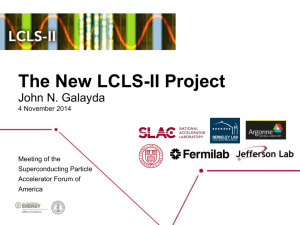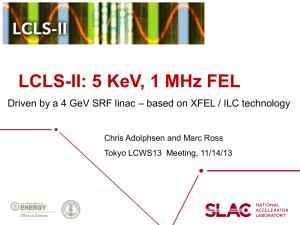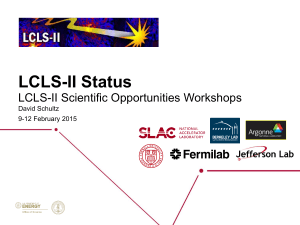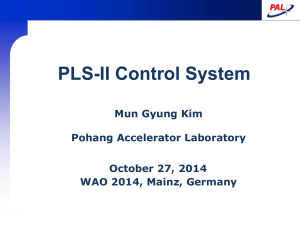130918 LCLS-IISC Parameters
advertisement
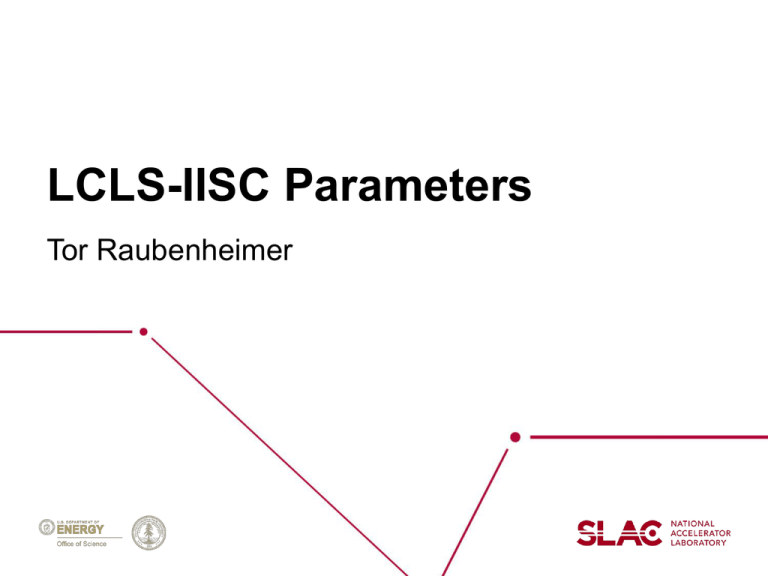
LCLS-IISC Parameters Tor Raubenheimer Operating modes •Two sources: high rate SCRF linac and 120 Hz NCu LCLS-I linac •North and south undulators always operate simultaneously in any mode Undulator SC Linac (up to 100kHz) North 0.25-1.2 keV South 1.0-5.0 keV Cu Linac (up to 120Hz) up to 18 keV higher peak power pulses • Concurrent operation of 1-5 keV and 5-18 keV is not possible 0.2-1.2 keV (100kHz) 4 GeV SC Linac Cu Linac LCLS-II Overview 1.0 - 18 keV (120 Hz) 1.0 - 5 keV (100 kHz) 2 Preliminary Operating Parameters Preliminary LCLS-II Summary Parameters North Side Source v0.7 8/30/13 South Side Source Running mode SC Linac SC Linac Cu Linac Repetition rate up to 1 MHz* up to 1 MHz* 120 Hz 4 GeV 4 GeV 14 GeV 0.25-1.2 keV 1-5 keV 1-20 keV up to 2 mJ* up to 2 mJ* up to10 mJ 3.9x1030 ** 12x1030 ** 247x1030 ** 3.0x1030 ** 6.9x1030 ** 121x1030 ** Electron Energy Photon energy Max Photon pulse energy (mJ) (full charge, long pulse) Peak Spectral Brightness (10 fs pulse) (low charge, 10pC) Peak Spectral Brightness (100fs pulse) (full charge, 100pC) * Limited by beam power on optics **N_photons/(s*mm^2*mrad^2*0.1% bandwidth) LCLS-II Overview 3 High Level Schedule Insert Presentation Title in Slide Master 4 More Immediate Schedule 1. Mid-October Workshop to review design, cost and schedule with collaborators 2. Mid-December Director’s Review for CD1 Review 3. Mid-January CD1 Lehman Review Also may need to have a FAC review prior to CD1 review Mid-November ?? Insert Presentation Title in Slide Master 5 Assumed Beam Parameters NLS NGLS LCLS-IISC Beam energy [GeV] 2.25 2.4 4 Bunch charge [pC] 200 300 100 Emittance [mm-mrad] 0.3 0.6 0.43 Energy spread [keV] 150 150 keV 300 keV Peak current [kA] 0.97 0.5 1 Useful bunch fraction [%] 40 50 50 The assumed emittance of 0.43 at 100 pC is roughly 25% larger than the LCLS-II baseline. It is more conservative than the NLS or the scaled NGLS values (the latter are consistent with the LCLS-II baseline) however a gun has not yet been demonstrated that achieves the desired emittances. Reduced emittances will decrease gain lengths. Peak current is consistent with higher energy beams and BC’s Insert Presentation Title in Slide Master 6 Example of Injector: APEX Insert Presentation Title in Slide Master 7 SCRF Linac Roughly 400 meters long including laser heater at ~100 MeV, BC1 at ~300 MeV and BC2 at 1000-2000 GeV. Long bypass line starting at Sector 9 BSY. LTU similar to LCLS-IISA discussed last month. Based on 1.3 GHz TESLA 9-cell cavity with minor mods for cw operation Insert Presentation Title in Slide Master 8 1.3 GHz 8-cavity cryomodule (CM) • It is proposed to use an existing cryomodule design for the 4-GeV LCLS-II SRF linac. • CM is roughly 13 meters for 8 cavities plus a quadrupole package • The best-fit is the EU-XFEL cryomodule • Modifications are required for LCLS-II • (The CEBAF 12 GeV upgrade module must also be considered) • (The ILC CM is similar but has several important differences and is not as well suited for CW application) • 100 cryomodules of this design will be built and tested by the XFEL by 2016 Global industrial support for this task • One XFEL ~prototype CM was assembled and tested at Fermilab • (Fermilab assembled an ILC cryomodule and has parts for another)\ 9 Linac v0.9 2013-08-30 Linac parameters 1.3 GHz Mod V 50 kV 1.3 GHz Mod A 10 A 1.32E+06 W Energy 4 GeV 1.3 GHz Sector-pair RF AC power Cavity Gradient 16 MV/m 1.3 GHz Cryomodule spacing 13 m 3.9 GHz cryomodules 3 count deg_K 3.9 GHz Voltage 60 MV 1E+06 Hz 3.9 GHz Cavities 12 count Average current 0.3 mA 3.9 GHz Cavities/klystron 4 count Beam power 1.2 MW L0 length 8 m Cryogenics power 3.0 MW L1 RF length 16 m Total SC RF AC Power 3.4 MW LC length (3.9 GHz) 4 m L2 RF length 96 m L3 RF length Total Linac length; not incl BC1 BC2 144 405 m m Cavity Q_0 Operational temperature rate 2E+10 1.8 SC Layout 1.3 GHz Cryomodules 34 (+1 spare) count 1.3 GHz Voltage 4.2 GV 1.3 GHz Cavities 264 count 1.3 GHz Rf power/cavity 7 kW 1.3 GHz Cavities/klystron 32 count 1.3 GHz SSA 24 count 1.3 GHz Cryomodules/klystron 4 count 1.3 GHz Dist. Between klystrons 57 m 3.0E+05 W 1.3 GHz Klystron avg. power 1.3 GHz Klystron (10% margin) 8 No warm breaks except BC: 1 cryo circuit per 3 kW load 10 Linac View SLAC Linac (11 wide x 10 feet high) (3.35 x 3.05 m) x 11 First 800 m of SLAC linac (1964): Cryoplant placement and construction 12 Assumed FEL Configuration • High rep rate beam could be directed to either of two undulators HXR or SXR bunch-by-bunch • 120 Hz beam could be directed to the HXR at separate times • The SC linac would be located in Sectors 0-10 and would be transported to BSY in the 2km long Bypass Line. It would use a dual stage bunch compressor. • A dechirper might be used to further cancel energy spread for greater flexibility in beam parameters • The high rep rate beam energy would be 4 GeV and the HXR would fill the LCLS hall with ~144 m while the SXR would be <75 m so that it could be fit into ESA • Both undulators would need to support self-seeding as well as other seeding upgrades Insert Presentation Title in Slide Master 13 Undulator Requirements Requirements: 1. SXR self-seeding operation between 0.2 and 1.3 keV in ESA tunnel (<75 meters) with 2.5 to 4 GeV beam 2. HXR self-seeding operation between 1.3 and 4 keV in LCLS tunnel (~144 meters) with 4 GeV beam 3. HXR SASE operation up to 5 keV with 4 GeV beam 4. Primary operation of SXR and TXR at constant beam energy large K variation 5. HXR operation comparable to present LCLS with 2 to 15 GeV beam Insert Presentation Title in Slide Master 14 Undulator Parameters 1. To cover the range of 0.2 to 1.3 keV using SASE in less than 50 meters (to allow for seeding) lw ~ 40 mm • A conventional hybrid undulator with 40 mm and a 7.2 mm minimum gap would have Kmax ~ 6.0 which easily covers the desired wavelength range at 4 GeV 2. To achieve 5 keV using SASE with less than 144 m at 4 GeV TXR lw <= 26 mm • • A conventional hybrid undulator with 26 mm and a 7.2 mm minimum gap would have Kmax ~ 2.4 which covers desired wavelength range at 4 GeV Provides reasonable performance with LCLS beam Insert Presentation Title in Slide Master 15 Baseline Tuning Range for 4 GeV HXR: lu = 26 mm, L = 144 m Kmin = 0.55 SXR: lu = 41 mm, L = 75 m SASE Self-Seeding Ephoton [keV] Kmin = 0.91 Kmin = 1.6 Self-Seeding Kmax = 2.44 Kmax = 6.0 Ebeam [GeV] Kmin is chosen to saturate within given length for SASE or Self-seeding Kmax is set to the maximum value for a 7.2 mm gap variable gap undulator X-ray pulse energy at High Rate More than enough FEL power although results assume full beam and are ~2x optimistic Insert Presentation Title in Slide Master 17 Comparison of HXR with LCLS performance at 120 Hz (1) 26 mm HXR covers 2 keV at ~4 GeV to 30+ keV at 14 GeV – beam energy might be reduced further if desired Insert Presentation Title in Slide Master 18 Comparison of HXR with LCLS performance at 120 Hz (2) 26 mm HXR provides lower pulse energy than 30 mm LCLS but much shorter l Insert Presentation Title in Slide Master 19 Options for HXR: SCU, IV, or 30 mm period (1) To recover the LCLS performance, we need to increase K. Can (1) increase the period, (2) adopt an in-vacuum design, or (3) consider a planar or helical SCU. Example of a helical SCU below however have not included poorer SCU fill factor results are optimistic Insert Presentation Title in Slide Master 20 Options for HXR: SCU, IV, or 30 mm period (2) Example of a 30 mm period hybrid undulator below. Nearly recovers LCLS performance (reduction due to slightly larger gap with VG undulator) however the maximum photon energy at high rate, i.e., 4 GeV is now 4.3 keV not 5 keV as with 26 mm period Insert Presentation Title in Slide Master 21 SCU options An SCU has a number of benefits: 1. Would attain comparable performance as LCLS even while achieving 5 keV at 4 GeV at high rate by operating with high K 2. Would allow shorter SXR period to reduce SXR beam energy and gain length to ensure space in ESA while still covering full wavelength range at constant energy. Insert Presentation Title in Slide Master 22 GENESIS SIMULATION ELECTRON PARAMETERS Centroid energy 4 GeV; 100 pC compressed to 1 kA; normalized emittance: 0.45 mrad; slice energy spread: sE = 300 keV except for LCLS case with 15 GeV 6 cases – details in following pages Good Case 1: HXR Kmin = 0.91; lw = 26 mm; Lw = 144 m (study SS 4keV) Case 2: SXR Kmin = 1.6; lw = 41 mm; Lw = 75 m (study 1.6 keV) Bad Case 3: SXR Kmax = 6.0; lw = 41 mm; Lw = 75 m (study 200 eV) Good Barely Case 4: SXR K = 1.9; lw = 41 mm; Lw = 75 m (study 1.3 keV) Case 5: SXR K = 2.0; lw = 30 mm; Lw = 75 m (short gain len.) Good OK Case 6: HXR in LCLS TW parameters but K too high for hybrid undulator J. Wu (SLAC), jhwu@slac.stanford.edu, 08/05/2013 23 Potential Areas of Collaboration with Partner Labs SLAC LBNL Injector X Undulator X FNAL JLAB X X SC Linac X X SC cryo line X X Cryo plant X X X X X RF systems X Beam Physics X Instruments/ Detectors X PM/Integration X Installation X Commissioning X LCLS-II Overview Cornell Wisconsin X X X SC linac prototype LLRF ANL X X X X X X 24 Points of Contact Insert Presentation Title in Slide Master 25 CDR Writing • Must keep the document concise – it is a conceptual design 1. 2. 3. 4. 5. 6. 7. 8. 9. 10. 11. 12. 13. 14. 15. 16. 17. 18. Executive Summary (Galayda) Scientific Objectives (TBD) Machine Performance and Parameters (Raubenheimer) Project Overview (Galayda) Electron Injector (Schmerge) Superconducting Linac Technologies (Ross,Corlett) Electron Bunch Compression and Transport (Raubenheimer, Emma) FEL Systems (Nuhn) Electron Beam Diagnostics (Frisch, Smith) Start-to-End Tracking Simulations (Emma) Photon Transport and Diagnostics (Rowen) Experimental End-Stations (Schlotter) Timing and Synchronization (Frisch) Controls and Machine Protection (Shoaee, Welch) Conventional Facilities (Law) Environment, Safety and Health (Healy) Radiological Issues (Rokni) Future Upgrade Options (Galayda) Insert Presentation Title in Slide Master 26
